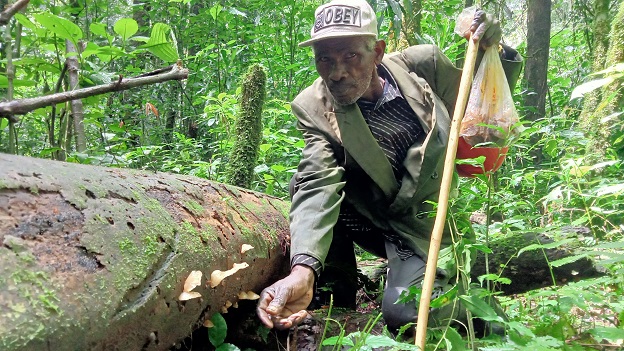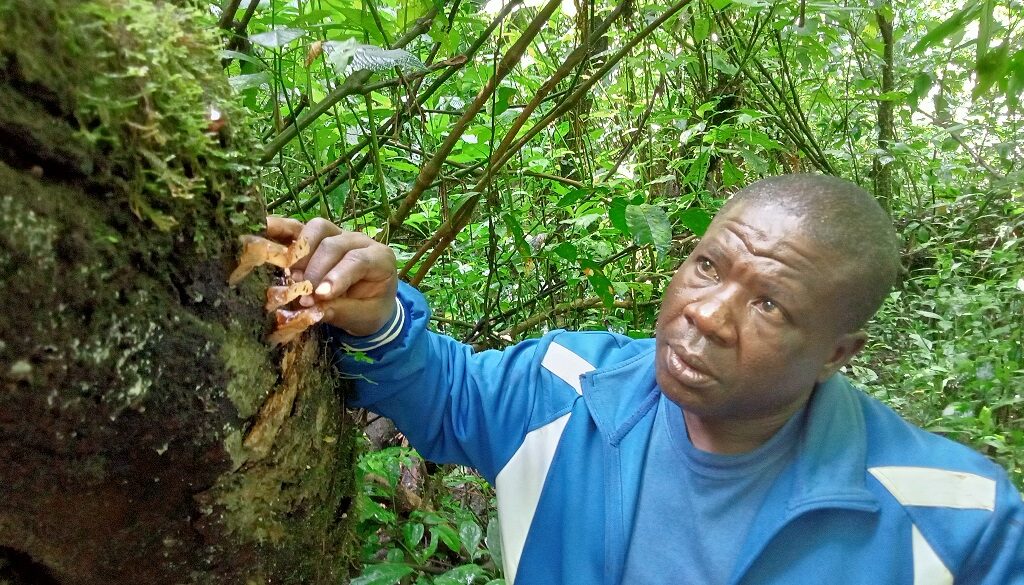
By Gabriel Ingubu
The birds of Kakamega Forest chirp as they move from one tree branch to another. The mid-altitude tropical rainforest that lies in the Lake Victoria catchment area is home to a variety of popular indigenous trees.
The trees offer a natural habitat for a popular delicacy – wood ear mushroom – locally known as matere. This type of mushroom is ear-shaped, brown, and gelatinous and is known for its crunchy texture and ability to soak in flavours.
Maurice Otunga, 60, is a mushroom collector. Dressed in a navy-blue nylon raincoat, black cap and gumboots as protection gear, he takes us to the best section of the forest to pick the mushrooms. In his hands are a panga for clearing the way and a small stick to scare away dangerous animals such as snakes.
“This wood ear mushroom only grows on wet logs and older trees that are exposed to the sun,” he says.
On average, Otunga sells about 100 kilogrammes of wood ear mushroom per month. The mushroom is so popular that young boys who graze their cattle, and women and girls who fetch firewood in the forest almost always carry some home as they leave the forest. A kilo of mushroom costs between Ksh400 and Ksh600 (2.5 to 4 dollars), says Kenya Climate Innovation Centre.
Patrick Muchiri, a senior technician and researcher at the Institute of Biotechnology Research at Jomo Kenyatta University of Agriculture and Technology, says mushrooms contain a wide variety of phenol and flavonoid antioxidant which are useful in strengthening the immune system.
According to National Farmers Information Service, Kenya produces 500 tonnes of mushrooms per year against an annual demand of 1,200 tonnes.
Locally, matere strains from the Albizia sapp tree (Mukangu), Ficus Exasparata (Museno) and Ficus Thorningu (Mukumu) are considered medicinal, and from the Elgon Teak, Funtumia Africana (Mutondo) Ficus Lutea (Mukavakava) and forest croton (Musutsu) are nutritious.
As a delicacy, matere can be prepared either fresh from the wild or dried. Dried matere should be soaked in water for one hour before cooking.
Locals advise that only ash filtrate is used to soften them. “You are not supposed to fry them, but instead boil them on low flame with salt and the filtrate. Frying them interferes with the original taste. It’s usually served with ugali,” advises a resident.
In the forest’s section with many quaver trees, a lot of mushrooms germinate after the onset of the first rain. We bump into yet another crew on the same mission in a different section of the forest.
This solidifies the need to protect the forest for the community to benefit from it without any destruction, thus contributing to the Sustainable Development Goals, including Goal 15, which seeks to protect, restore and promote sustainable use of terrestrial ecosystems, sustainably manage forests, combat desertification, and halt and reverse land degradation and halt biodiversity loss.

Already, the rehabilitation and restoration of Kakamega Forest, which entails the erection of the 117km perimeter electric fence and reforestation of some 220 hectares of degraded forest land, has started.
Most members of the local Community Forest Association are advocating for controlled and monitored movements in and out of the forest to reduce illegal business of charcoal burning and cutting trees.
James Ligare, chairperson of User Right Tree Nursery Group and Muliru Farmers Association, advocates for the fencing. He says gathering anything in the forest interferes with other parts of nature like insect colonies, small plants and nests of small animals and birds through clearing paths and stepping on them.
Through sensitisation, the surrounding community has learnt that there will be demarcated gates to allow them to access and use the forest.
“Fencing is a good idea. Our police are too few for the area they cover and that’s why tree cutting, wildlife hunting and charcoal burning are still being practiced,” Otunga says. He adds that charcoal burners are the greatest enemies of logs that give him good mushrooms and so if the forest is fenced, they may keep off.
Some trees on which the mushrooms grow are only a preserve of the forest, and folklore has been used over the years to keep it that way. For example, the croton megalacarpus, is seen as a bad omen, capable of bringing misfortune to a household, and thus cannot be domesticated.
“How possible is that a bad omen tree is the one with the best ear wood mushroom?” asks Solomon Watai, the secretary of Machetto Community Forest Association and in charge of Research and Education user group.
He says the older generation knew the importance of such trees, thus they created scary stories about them so that they can be preserved. He has vowed to lead women and youth to take tree planting as a venture to earn cash and protect the future.
Dr Isaac Misiko, a researcher on fauna and flora in Bungoma County, says while domestication of indigenous trees is a good idea, it should be for the long term. Most indigenous tree species take more than 50 years to mature.
“The ecosystem in the wild greatly differs from home environment, making it difficult for some trees to grow well when domesticated. The wild has more hidden elements than we can see with our eyes and these elements are the ones that support symbiotic relationships that facilitate growth and sustainability of trees,” says Dr Misiko.
Rhoda Ombwara, Forest Station Manager at Kenya Forest Service Malava station, believes that it is only through social forestry that conservation of the forest will be appreciated by the community.
“Communities around the forest within the range of five kilometres are all members of the Community Forest Association. Through trainings and linkages, they keep a protective eye on the forest, which makes my work easer,” says Rhoda.
This story was produced with support from JRS Biodiversity Foundation and MESHA

Leave A Comment